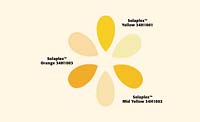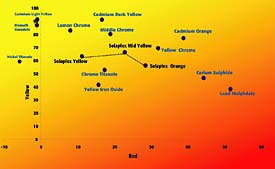

Bright yellow, orange and red shades are particularly challenging, with preferential reformulation away from cadmium pigments and lead chromates within the plastics and surface coatings markets. While cadmium has restricted use within Europe, lead chromates carry no legislative restriction (apart from decorative paint applications). However, industries are leading the way; the consumer-related decorative and automotive paint producers have not used lead-based pigments for some years. Powder coating producers have been working on a voluntary ban on lead chromate pigments which, as of this writing, should be in place by year end 2003.
Customers are facing the challenge of matching traditional color targets with alternative pigment systems, while remaining competitive and protecting their margins. Inevitably, the attractive bright shades are the most difficult to reformulate, since heavy metal formulations often come hand in hand with color brilliance, technical performance and ease of use.

High Performance
High performance is of paramount importance to many plastics and surface coating industries, where pigments must endure harsh environments during processing or in-use. The pigment itself often acts as a functional component, protecting and prolonging the lifetime of the coating. Reformulation is, therefore, more than just a color issue.More Options
Pigment suppliers have developed their own approach to the problem, but all are working within the confines of the traditional pigment types available. All approaches have their own advantages, but no single pigment appears to be meeting every need. Is there room for another pigment type in the raw material palette? Johnson Matthey believes that there is.
Lead chromates have been predominantly replaced by organic/inorganic pigment blends. In most cases, organic pigments are combined with titanium dioxide, mixed metal oxide titanates, yellow iron oxide, or a combination, to impart opacity to the coating or polymer. Due to the low color strength of the inorganic component, high organic pigment loadings are usually required to achieve bright colors.
The overall performance of these formulations will be determined by the organic component selected. From our observations, the following problems may be encountered, particularly for high-performance applications:
- The heat stability of the organic component may not be sufficient, particularly for engineering polymers (ABS, PEI, PEEK, PA, PBT, PC) or dark-colored coatings where heat build up may generate high temperatures in use.
- The chemical resistance of organic colorants may not always be adequate for reactive polymers, for example, polyamides, acid-catalyzed systems or coatings exposed to acid environments.
- The high oil absorption of the organic pigment may present rheology problems in coatings when high loadings are used to achieve bright yellow color targets.
- Organic pigments can be prone to migration and bleeding.
- Conventional inorganic pigments lack color brightness and intensity, and therefore color options are restricted for brighter shades.
Bismuth vanadate is a popular choice. Although attractive from a color perspective, options are limited in single pigment formulations; bismuth vanadate is often combined with organic pigments to achieve the full range of colors from yellow through to red. In general, the redder the color target, the higher the organic pigment loading required; this can be a costly pigment combination with the potential for some of the above noted problems. Bismuth vanadate is weatherfast and opaque to UV light but may exhibit thermal and chemical stability problems in very challenging applications. There is a gap in the high-performance yellow-orange color space.

A New Chemistry
Our new Solaplex™ range of pigments offers unique color properties, exceptional performance and the excellent durability associated with our Colourplex® range of mixed metal oxides. Solaplex™ pigments offer environmentally acceptable solutions, at an affordable price, in the challenging yellow color space.
Solaplex™ pigments are a new chemistry offering an environmentally acceptable alternative to pigments that contain cadmium, lead, chromium, nickel, antimony and molybdenum. The chemistry falls within the Rutile Tin Zinc family of compounds and has a new CI reference number, Pigment Yellow 216.
A New Color Space
Solaplex™ pigments lie in a completely unique color space, with a color shade and intensity between lead chromates and conventional titanates. They can be combined with green-shade yellow bismuth vanadate and organic pigments to produce a full color palette across the yellow to red color quadrant.
Technical Performance
Solaplex™ pigments offer a combination of color and performance benefits, unmatched by conventional pigment types.- New color space
- Cost-effective formulation options
- Excellent opacity and hiding power
- Excellent weatherfastness and lightfastness
- Excellent chemical resistance
- Good temperature stability
- Excellent dispersibility
- Low abrasiveness
- Low oil absorption; no adverse effect on binder rheology
- Non-migratory and non-warping
Application
Solaplex™ pigments are recommended for even the most demanding applications in the plastics, coatings and artist colors industries. They are ideal for the coloration of exterior decorative, industrial and architectural coatings, masonry coatings, powder coatings, coil coatings, and automotive coatings, including transportation.The agricultural, construction and engineering markets often use bright yellow for visibility and identity; diggers and power tools are often assembled from components colored with a wide range of plastic and coating technologies. The universal nature of these pigments means that all parts can be colored with the same pigment system, reducing color variation.
Road markings, signs and safety markings are often bright yellow. Yacht and marine applications demand extreme durability to protect against extreme weather conditions and salty environments.
Value-in-Use
Industry-standard color targets, for example, RAL 1003 Signal Yellow, can be formulated using a range of raw materials. Table 1 illustrates how this target can be achieved with lead chromates, nickel antimony titanate, bismuth vanadate or Solaplex™ pigments as the dominant option. In each case, formulations have been tested in alkyd melamine paint, at equivalent opacity and a dry film thickness of 60 microns.
Using the highest performance organic pigments, Solaplex™ pigments offer cost-effective, lead-free formulations by partial replacement of the costly organic content and/or bismuth vanadate, combined with the potential for performance improvements. A 100% inorganic formulation for RAL 1003 is now possible.
Summary
Solaplex™ technology offers an environmentally friendly alternative to cadmium and lead containing pigments. They are not classified as hazardous under the CHIP3 regulations, 2002, and the attendant EU directives (67/548/EEC, 88/379/EEC), neither are they classified as "special waste". They comply with the European Guideline for Indirect Food Contact (AP(89)1) and Toys Test for Plastics (EN71: Part 3), based on the analysis of typical batches. The Solaplex™ range offers new color options, affordable and robust for any application, complimenting and enhancing the formulator's raw material palette.For more information, contact Johnson Matthey Pigments & Dispersions, 11400 New Berlin Road, Jacksonville, FL 32226; phone 904/751.2828; e-mail sales inquiries to larry.lane@matthey.com or mike.mckenna@matthey.com, and technical support questions to helen.hatcher@matthey.com or andrew.tocher@matthey.com. Or visit www.JMSolaplex.com.

Report Abusive Comment